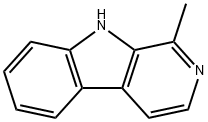Chemical Properties
Off-White Solid
Uses
- Harmane was used in trace level determination of harmane by planar chromatography coupled with (tandem) mass spectrometry.
- It was used to study interactions of norharman and harman with DNA.
- It may be used as matrix for analysis of cyclodextrins and for sulfated oligosaccharides in combination with DHB as co-matrix.
Uses
Harman alkaloid like harmane, harmine, harmalol, harmaline obtained from Banisteriopsis caapi L. showed cytotoxicity, antimicrobial activity against Staphylococcus aureus, Escherichia coli, Proteus vulgaris and Candida albicans.
Definition
ChEBI: An indole alkaloid fundamental parent with a structure of 9H-beta-carboline carrying a methyl substituent at C-1. It has been isolated from the bark of Sickingia rubra, Symplocus racemosa, P
ssiflora incarnata, Peganum harmala, Banisteriopsis caapi and Tribulus terrestris, as well as from tobacco smoke. It is a specific, reversible inhibitor of monoamine oxidase A.
General Description
- Harmane is a potent tremor-producing β-carboline alkaloid and neurotoxin.
- It is major representative of heterocyclic aromatic amines, a group of mutagenic and carcinogenic substances which are formed in meat from the precursors creatine, creatinine, amino acids and sugars during the heating at high temperatures.
- Blood harmane concentration is elevated in essential tremor, late-life neurological disease.
Biological Activity
Proposed as the endogenous ligand for imidazoline binding sites. Binds to I 1 -sites in rat kidney with an IC 50 of 31 nM, and I 2 -sites with a K i of 49 nM. In vivo, produces a dose-dependent hypotension that is reversed by efaroxan (2-(2-Ethyl-2,3-dihydro-2-benzofuranyl)-4,5-dihydro-1H-imidazole hydrochloride ). Also a potent inhibitor of monoamine oxidases A and B (I 50 values are 0.5 and 5 μ M respectively).
Biochem/physiol Actions
I1 imidazoline binding site agonist.



